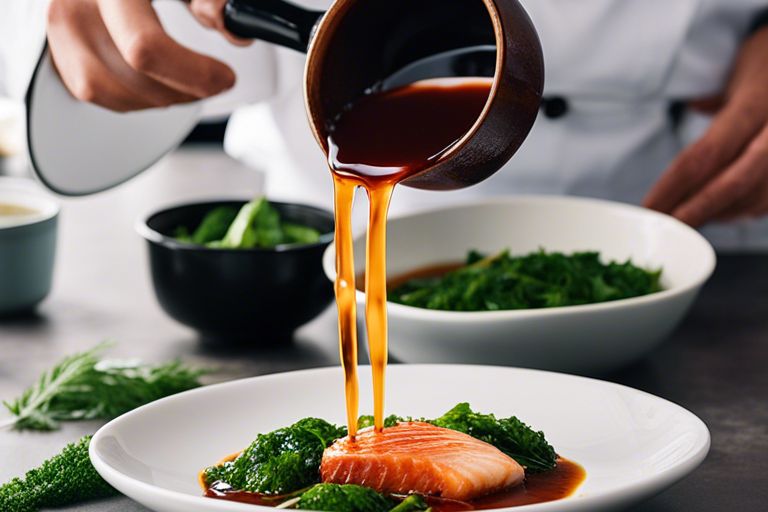This comprehensive guide will show you how to take your culinary skills to the next level by incorporating seaweed-based fish sauce into your dishes. Not only does this unique ingredient add a depth of umami flavor to your cooking, but it also provides a healthy dose of minerals, vitamins, and antioxidants. Learn how to use this nutrient-rich sauce in various recipes, from stir-fries to marinades, and elevate the taste of your favorite dishes effortlessly.
Key Takeaways:
- Seaweed-based fish sauce enhances flavors: Using seaweed-based fish sauce can add a unique umami flavor to your dishes, enhancing the overall taste profile.
- Health benefits of seaweed: Incorporating seaweed-based fish sauce into your recipes can offer health benefits, including potential antioxidant and anti-inflammatory properties.
- Versatility in cooking: Seaweed-based fish sauce can be used in a variety of dishes, such as stir-fries, marinades, soups, and dressings, providing a depth of flavor and richness to your cooking.

The Basics of Seaweed-based Fish Sauce
If you’re looking to elevate the flavors of your dishes, seaweed-based fish sauce is a game-changer. Not only does it add a unique umami richness, but it also brings a host of health benefits to the table. In this guide, we will investigate into the importants of creating this magical condiment that will take your culinary creations to the next level.
Understanding the Different Types of Seaweed
An important aspect of crafting the perfect seaweed-based fish sauce is understanding the different types of seaweed available. Each type brings its own set of flavors, nutritional benefits, and textures to the table. Here is a breakdown of the most common seaweeds used in fish sauce production:
| Nori | Kombu |
| Dulse | Wakame |
| Agar | Hijiki |
| Sea Lettuce | Bladderwrack |
| Irish Moss | Spirulina |
Any seaweed can be used for fish sauce, but the type you choose will impact the final taste and nutritional profile of your sauce.
Key Factors in Selecting Quality Seaweed for Your Sauce
With the abundance of seaweed varieties available, selecting the right one for your fish sauce is crucial. When choosing seaweed for your sauce, consider factors such as flavor intensity, texture, nutritional content, and sustainability. Look for seaweed that is fresh, free from contaminants, and sustainably sourced to ensure the highest quality product.
- Flavor intensity can vary greatly among different seaweed types, so choose one that complements your dish.
- Texture is an important factor to consider when selecting seaweed for your sauce, as it will affect the overall mouthfeel of the dish.
- Check the nutritional content of the seaweed to ensure you are getting all the health benefits it has to offer.
- Opt for sustainably sourced seaweed to support environmentally friendly practices in the seafood industry.
Understanding these key factors will help you make an informed decision when choosing the right seaweed for your sauce. Any compromises in quality can affect the taste and nutrient profile of your final product, so choose wisely.
How-To Create Your Own Seaweed Fish Sauce
Essential Equipment and Ingredients
Now, before you commence on making your own seaweed fish sauce, it’s crucial to gather all the necessary equipment and ingredients. You will need a large glass jar, dried seaweed, sea salt, water, and a fine mesh strainer.
Step-by-Step Process for Making Seaweed Fish Sauce
There’s a simple step-by-step process involved in making your own seaweed fish sauce. Here is a breakdown of the process in the table below:
| Step | Instructions |
| 1 | Soak dried seaweed in water |
| 2 | Add sea salt to the mixture |
| 3 | Let the mixture ferment for several weeks |
| 4 | Strain the liquid using a fine mesh strainer |
For instance, the fermentation process is crucial as it allows the natural enzymes to break down the seaweed and salt, creating a rich umami flavor in the sauce.
Tips for Perfecting the Flavor Profile
HowTo achieving the perfect flavor profile for your seaweed fish sauce involves a few key tips. Enhance the taste by adding garlic, ginger, or chili peppers during the fermentation process. This will add depth and complexity to the sauce.
- Experiment with different seaweed varieties to find your preferred flavor profile
- Use high-quality sea salt for the best results
- Adjust the fermentation time to control the strength of the sauce
Sauce. This will help you tailor the sauce to your taste preferences and create a truly unique condiment that will enhance your dishes.
Incorporating Seaweed Sauce into Your Dishes
Best Practices for Using Seaweed Fish Sauce in Recipes
For best results when using seaweed fish sauce in your recipes, it is recommended to use it as a finishing touch rather than a base flavor. Adding a few drops of this umami-rich sauce at the end of cooking will enhance the overall flavor profile of your dish without overpowering it. Be mindful of, a little goes a long way with seaweed fish sauce.
Pairing Seaweed Sauce with Different Cuisines
Any cuisine that features seafood as a prominent ingredient can benefit from the addition of seaweed fish sauce. Its salty, briny flavor complements dishes like sushi, ceviche, and seafood boils exceptionally well. Additionally, seaweed fish sauce can also be used in Asian dishes such as stir-fries, noodle soups, and marinades, bringing a depth of flavor that is unparalleled.
Seaweed fish sauce is a versatile condiment that can elevate dishes from various cuisines. It adds a unique umami depth and richness that enhances the overall taste experience. Whether you are cooking Asian, Mediterranean, or fusion cuisine, experimenting with seaweed fish sauce can take your culinary creations to the next level.
Advanced Techniques and Ideas
Now, as you become more comfortable with incorporating seaweed-based fish sauce into your dishes, it’s time to explore some advanced techniques and creative ideas to elevate your culinary creations even further.
Customizing Your Seaweed Fish Sauce
Clearly, one of the exciting aspects of using seaweed-based fish sauce is the ability to customize it to suit your palate. Experiment with different types of seaweed, herbs, spices, and fermentation times to create a unique flavor profile that complements your dishes perfectly.
Creative Uses for Seaweed Fish Sauce in Modern Cooking
Seaweed fish sauce adds a depth of umami flavor to a wide range of dishes, from traditional Asian stir-fries to Western dishes like burgers and roasted vegetables. Incorporating it into marinades, dressings, and sauces can enhance the overall taste and offer a unique twist to familiar recipes.
Plus, the nutritional benefits of seaweed-based fish sauce, such as its rich source of iodine and other minerals, make it a healthy choice for your cooking.
Conclusion
To wrap up, incorporating seaweed-based fish sauce into your dishes can elevate the flavors to new heights. This guide has provided you with valuable tips and steps on how to make your own seaweed-infused fish sauce at home. By following these easy steps, you can enjoy the unique umami richness and health benefits that seaweed brings to your dishes. Experiment with different seaweed varieties and cooking techniques to discover new depths of flavor in your culinary creations. Enhance your dishes with seaweed-based fish sauce and impress your family and friends with delicious and nutritious meals.
FAQ
Q: What is seaweed-based fish sauce?
A: Seaweed-based fish sauce is a condiment made from fermented fish and seaweed extracts. It is commonly used in Asian cuisine to add a savory and umami flavor to dishes.
Q: How can seaweed-based fish sauce enhance my dishes?
A: Seaweed-based fish sauce can enhance your dishes by adding a deep and rich umami flavor. It can be used as a marinade, a seasoning, or a dipping sauce to elevate the taste of your meals.
Q: How do I use seaweed-based fish sauce in my cooking?
A: You can use seaweed-based fish sauce in various ways, such as adding it to stir-fries, soups, marinades, and dressings. Start by adding a small amount and adjust to taste to avoid overpowering the dish.

